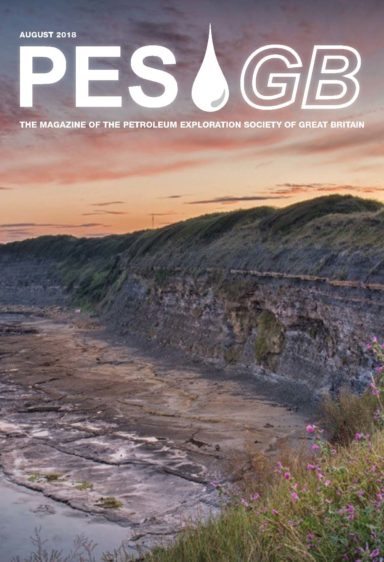PESGB August 2018
Plus much more inside
 Mid-Year Performance Review
Mid-Year Performance Review
The days are long and the sun is shining. Apart from an overdue summer break, this timing normally heralds the prospect of a mid-year review and the realisation that the second half of the year really ought to be a lot better than the first.
Nobody requires a reminder that we are tentatively emerging from a very difficult period in our industry. The UKCS saw well counts dropping to ten-year lows in 2015. Most countries in our region have been impacted by the offset of low commodity prices and high project costs. The pivotal policy announcement in The Netherlands that production from the Groningen field will cease by 2030 may also have longer reaching effects for exploration in that sector.
As I write this in early July 2018, Norway continues to dominate E&A well spuds in the region, with 11 wells drilled in the first half of the year. OMV drilled the Hades/Iris prospect in the Norwegian Sea during April and found gas condensate in volumes above pre-drill estimates. The Barents Sea continues to be a challenging petroleum system, with the Aker-BP Svanefjell well on the Loppa High being a small gas discovery and Lundin coming empty-handed with their Hurri prospect. This was the latest of 10 dry wells spudded in the Barents Sea during 2017. The biggest disappointment was the Korpfjell well, drilled in a formerly disputed zone close to the Russian border by Equinor (then Statoil), which reportedly found non-commercial gas. The overall pessimism in Norway was compounded by the 24th licencing round, where only 11 companies bid, representing a significant reduction compared with previous rounds.
In the UK, the big news was the 30th Offshore Licencing Round, which injected some much-needed life into the sector and was where 61 companies won 123 licences and 229 blocks. Companies bid 8 firm wells and 14 licences will proceed straight to field development. Interestingly, this round witnessed the return of the supermajors (e.g. BP, Shell and Equinor) and the appearance of a range of new entrant smaller companies (e.g. Spark Exploration and Tangram Energy). The 8 wells bid brings some optimism to an otherwise disappointing 2018, where only 2 E&A wells have been so far completed by Apache. The remainder of 2018 still looks promising with 14 wells planned, including Siccar Point’s Lyon prospect in the West of Shetland. There has been the fear in recent years that the lack of new E&A drilling in the UK sector would result in limited new project sanctioning in years to come. The field development commitments made in the 30th round could mean that this gap is partially bridged, particularly through Chrysaor’s plans for the Ockley and Faraday fields, which are material high pressure / high temperature discoveries. On top of this, Shell has approved its second field development in six months and BP has increased its equity in the Clair Field, as industry finds new ways to find value in previously uneconomic / mature resources.
In Ireland, industry has taken a breather since the pre-drill excitement surrounding the Providence well in 2017, which targeted stacked prospectivity in the Paleocene and Cretaceous. The next planned drilling is likely to be in 2019, when CNOOC is expected to pursue the Iolar prospect in the adjacent block to Providence, but this time targeting the deeper Jurassic syn-rift.
In the Netherlands, 5 exploration wells have been completed in 2018, including 3 discoveries (L10-39 operated by Engie, the Tanzaniet prospect in the GEms area on the border with Germany with sidetrack N07-04A-S1 operated by ONE, and D12-07 operated by Wintershall).
In summary, the mid-year performance review for the E&P industry in our region is much like my own – good start, but could do a whole lot better during the rest of 2018.
The PESGB mid-year performance review is looking somewhat rosier. Early indications are that the recent London SEAPEX conference was successful and we have an exciting six months ahead of us, with the Houston-located HGS/PESGB Africa Conference in September and PETEX / PROSPEX later in the year.


